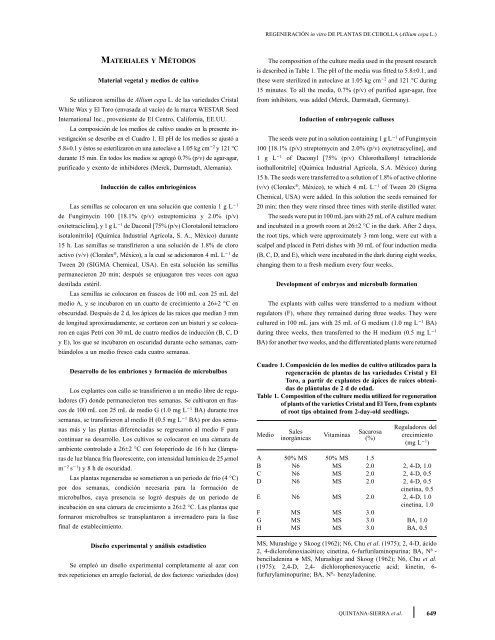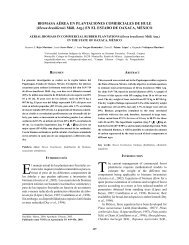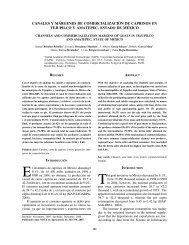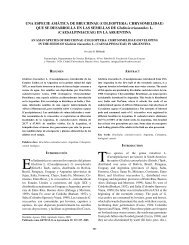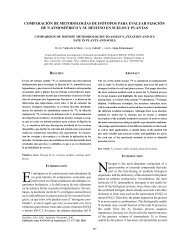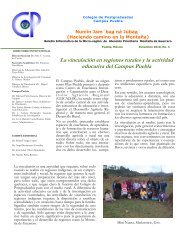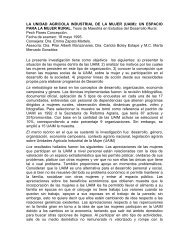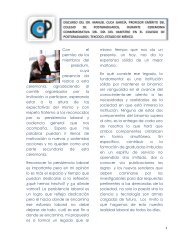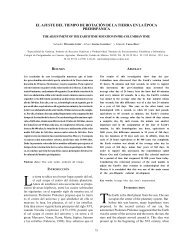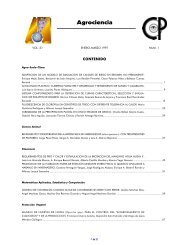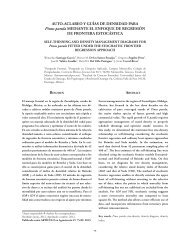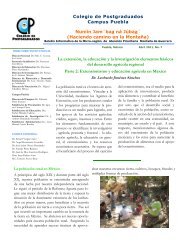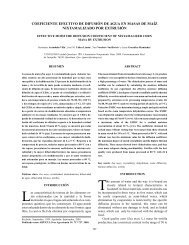04-161 (Regeneración in vitro) - Colegio de Postgraduados
04-161 (Regeneración in vitro) - Colegio de Postgraduados
04-161 (Regeneración in vitro) - Colegio de Postgraduados
You also want an ePaper? Increase the reach of your titles
YUMPU automatically turns print PDFs into web optimized ePapers that Google loves.
MATERIALES Y MÉTODOS<br />
Material vegetal y medios <strong>de</strong> cultivo<br />
Se utilizaron semillas <strong>de</strong> Allium cepa L. <strong>de</strong> las varieda<strong>de</strong>s Cristal<br />
White Wax y El Toro (envasada al vacío) <strong>de</strong> la marca WESTAR Seed<br />
International Inc., proveniente <strong>de</strong> El Centro, California, EE.UU.<br />
La composición <strong>de</strong> los medios <strong>de</strong> cultivo usados en la presente <strong>in</strong>vestigación<br />
se <strong>de</strong>scribe en el Cuadro 1. El pH <strong>de</strong> los medios se ajustó a<br />
5.8±0.1 y éstos se esterilizaron en una autoclave a 1.05 kg cm−2 y 121 °C<br />
durante 15 m<strong>in</strong>. En todos los medios se agregó 0.7% (p/v) <strong>de</strong> agar-agar,<br />
purificado y exento <strong>de</strong> <strong>in</strong>hibidores (Merck, Darmstadt, Alemania).<br />
Inducción <strong>de</strong> callos embriogénicos<br />
Las semillas se colocaron en una solución que contenía 1 g L −1<br />
<strong>de</strong> Fungimyc<strong>in</strong> 100 [18.1% (p/v) estreptomic<strong>in</strong>a y 2.0% (p/v)<br />
oxitetracicl<strong>in</strong>a], y 1 g L−1 <strong>de</strong> Daconil [75% (p/v) Clorotalonil tetracloro<br />
isotalonitrilo] (Química Industrial Agrícola, S. A., México) durante<br />
15 h. Las semillas se transfirieron a una solución <strong>de</strong> 1.8% <strong>de</strong> cloro<br />
activo (v/v) (Cloralex ® , México), a la cual se adicionaron 4 mL L −1 <strong>de</strong><br />
Tween 20 (SIGMA Chemical, USA). En esta solución las semillas<br />
permanecieron 20 m<strong>in</strong>; <strong>de</strong>spués se enjuagaron tres veces con agua<br />
<strong>de</strong>stilada estéril.<br />
Las semillas se colocaron en frascos <strong>de</strong> 100 mL con 25 mL <strong>de</strong>l<br />
medio A, y se <strong>in</strong>cubaron en un cuarto <strong>de</strong> crecimiento a 26±2 °C en<br />
obscuridad. Después <strong>de</strong> 2 d, los ápices <strong>de</strong> las raíces que medían 3 mm<br />
<strong>de</strong> longitud aproximadamente, se cortaron con un bisturí y se colocaron<br />
en cajas Petri con 30 mL <strong>de</strong> cuatro medios <strong>de</strong> <strong>in</strong>ducción (B, C, D<br />
y E), los que se <strong>in</strong>cubaron en oscuridad durante ocho semanas, cambiándolos<br />
a un medio fresco cada cuatro semanas.<br />
Desarrollo <strong>de</strong> los embriones y formación <strong>de</strong> microbulbos<br />
Los explantes con callo se transfirieron a un medio libre <strong>de</strong> reguladores<br />
(F) don<strong>de</strong> permanecieron tres semanas. Se cultivaron en frascos<br />
<strong>de</strong> 100 mL con 25 mL <strong>de</strong> medio G (1.0 mg L−1 BA) durante tres<br />
semanas, se transfirieron al medio H (0.5 mg L−1 BA) por dos semanas<br />
más y las plantas diferenciadas se regresaron al medio F para<br />
cont<strong>in</strong>uar su <strong>de</strong>sarrollo. Los cultivos se colocaron en una cámara <strong>de</strong><br />
ambiente controlado a 26±2 °C con fotoperíodo <strong>de</strong> 16 h luz (lámparas<br />
<strong>de</strong> luz blanca fría fluorescente, con <strong>in</strong>tensidad lumínica <strong>de</strong> 25 µmol<br />
m −2 s −1 ) y 8 h <strong>de</strong> oscuridad.<br />
Las plantas regeneradas se sometieron a un período <strong>de</strong> frío (4 °C)<br />
por dos semanas, condición necesaria para la formación <strong>de</strong><br />
microbulbos, cuya presencia se logró <strong>de</strong>spués <strong>de</strong> un periodo <strong>de</strong><br />
<strong>in</strong>cubación en una cámara <strong>de</strong> crecimiento a 26±2 °C. Las plantas que<br />
formaron microbulbos se transplantaron a <strong>in</strong>verna<strong>de</strong>ro para la fase<br />
f<strong>in</strong>al <strong>de</strong> establecimiento.<br />
Diseño experimental y análisis estadístico<br />
Se empleó un diseño experimental completamente al azar con<br />
tres repeticiones en arreglo factorial, <strong>de</strong> dos factores: varieda<strong>de</strong>s (dos)<br />
REGENERACIÓN <strong>in</strong> <strong>vitro</strong> DE PLANTAS DE CEBOLLA (Allium cepa L.)<br />
The composition of the culture media used <strong>in</strong> the present research<br />
is <strong>de</strong>scribed <strong>in</strong> Table 1. The pH of the media was fitted to 5.8±0.1, and<br />
these were sterilized <strong>in</strong> autoclave at 1.05 kg cm−2 and 121 °C dur<strong>in</strong>g<br />
15 m<strong>in</strong>utes. To all the media, 0.7% (p/v) of purified agar-agar, free<br />
from <strong>in</strong>hibitors, was ad<strong>de</strong>d (Merck, Darmstadt, Germany).<br />
Induction of embryogenic calluses<br />
The seeds were put <strong>in</strong> a solution conta<strong>in</strong><strong>in</strong>g 1 g L−1 of Fungimyc<strong>in</strong><br />
100 [18.1% (p/v) streptomyc<strong>in</strong> and 2.0% (p/v) oxytetracycl<strong>in</strong>e], and<br />
1 g L−1 of Daconyl [75% (p/v) Chlorothallonyl tetrachlori<strong>de</strong><br />
isothallonitrile] (Química Industrial Agrícola, S.A. México) dur<strong>in</strong>g<br />
15 h. The seeds were transferred to a solution of 1.8% of active chlor<strong>in</strong>e<br />
(v/v) (Cloralex ® , México), to which 4 mL L −1 of Tween 20 (Sigma<br />
Chemical, USA) were ad<strong>de</strong>d. In this solution the seeds rema<strong>in</strong>ed for<br />
20 m<strong>in</strong>; then they were r<strong>in</strong>sed three times with sterile distilled water.<br />
The seeds were put <strong>in</strong> 100 mL jars with 25 mL of A culture medium<br />
and <strong>in</strong>cubated <strong>in</strong> a growth room at 26±2 °C <strong>in</strong> the dark. After 2 days,<br />
the root tips, which were approximately 3 mm long, were cut with a<br />
scalpel and placed <strong>in</strong> Petri dishes with 30 mL of four <strong>in</strong>duction media<br />
(B, C, D, and E), which were <strong>in</strong>cubated <strong>in</strong> the dark dur<strong>in</strong>g eight weeks,<br />
chang<strong>in</strong>g them to a fresh medium every four weeks.<br />
Development of embryos and microbulb formation<br />
The explants with callus were transferred to a medium without<br />
regulators (F), where they rema<strong>in</strong>ed dur<strong>in</strong>g three weeks. They were<br />
cultured <strong>in</strong> 100 mL jars with 25 mL of G medium (1.0 mg L−1 BA)<br />
dur<strong>in</strong>g three weeks, then transferred to the H medium (0.5 mg L−1 BA) for another two weeks, and the differentiated plants were returned<br />
Cuadro 1. Composición <strong>de</strong> los medios <strong>de</strong> cultivo utilizados para la<br />
regeneración <strong>de</strong> plantas <strong>de</strong> las varieda<strong>de</strong>s Cristal y El<br />
Toro, a partir <strong>de</strong> explantes <strong>de</strong> ápices <strong>de</strong> raíces obtenidas<br />
<strong>de</strong> plántulas <strong>de</strong> 2 d <strong>de</strong> edad.<br />
Table 1. Composition of the culture media utilized for regeneration<br />
of plants of the varieties Cristal and El Toro, from explants<br />
of root tips obta<strong>in</strong>ed from 2-day-old seedl<strong>in</strong>gs.<br />
Reguladores <strong>de</strong>l<br />
Medio<br />
Sales<br />
Vitam<strong>in</strong>as<br />
Sacarosa<br />
<strong>in</strong>orgánicas (%)<br />
crecimiento<br />
(mg L−1 )<br />
A 50% MS 50% MS 1.5<br />
B N6 MS 2.0 2, 4-D, 1.0<br />
C N6 MS 2.0 2, 4-D, 0.5<br />
D N6 MS 2.0 2, 4-D, 0.5<br />
c<strong>in</strong>et<strong>in</strong>a, 0.5<br />
E N6 MS 2.0 2, 4-D, 1.0<br />
c<strong>in</strong>et<strong>in</strong>a, 1.0<br />
F MS MS 3.0<br />
G MS MS 3.0 BA, 1.0<br />
H MS MS 3.0 BA, 0.5<br />
MS, Murashige y Skoog (1962); N6, Chu et al. (1975); 2, 4-D, ácido<br />
2, 4-diclorofenoxiacético; c<strong>in</strong>et<strong>in</strong>a, 6-furfurilam<strong>in</strong>opur<strong>in</strong>a; BA, N 6 -<br />
bencila<strong>de</strong>n<strong>in</strong>a ❖ MS, Murashige and Skoog (1962); N6, Chu et al.<br />
(1975); 2,4-D, 2,4- dichlorophenoxyacetic acid; k<strong>in</strong>et<strong>in</strong>, 6furfurylam<strong>in</strong>opur<strong>in</strong>e;<br />
BA, N 6 - benzyla<strong>de</strong>n<strong>in</strong>e.<br />
QUINTANA-SIERRA et al.<br />
649


